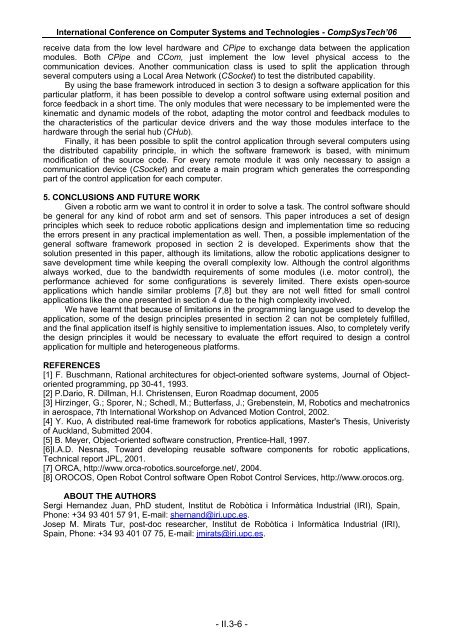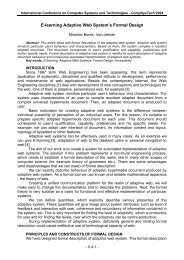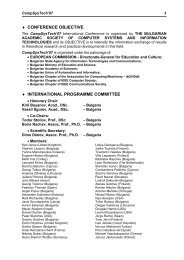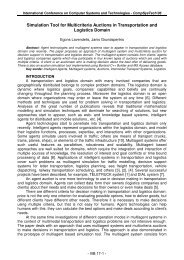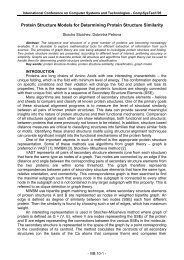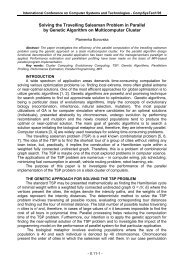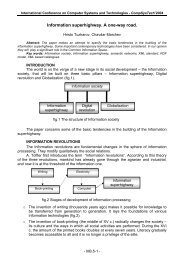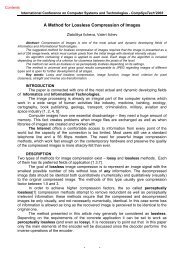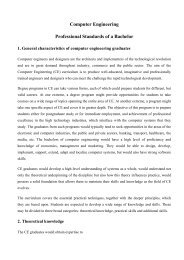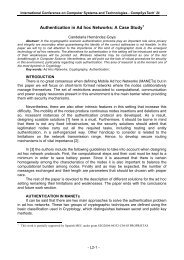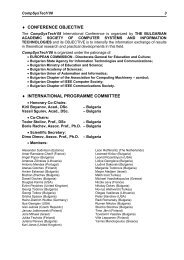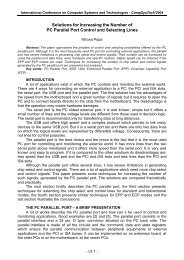Generic modular framework for robotic arm applications - Ecet
Generic modular framework for robotic arm applications - Ecet
Generic modular framework for robotic arm applications - Ecet
Create successful ePaper yourself
Turn your PDF publications into a flip-book with our unique Google optimized e-Paper software.
International Conference on Computer Systems and Technologies - CompSysTech’06receive data from the low level hardware and CPipe to exchange data between the applicationmodules. Both CPipe and CCom, just implement the low level physical access to thecommunication devices. Another communication class is used to split the application throughseveral computers using a Local Area Network (CSocket) to test the distributed capability.By using the base <strong>framework</strong> introduced in section 3 to design a software application <strong>for</strong> thisparticular plat<strong>for</strong>m, it has been possible to develop a control software using external position and<strong>for</strong>ce feedback in a short time. The only modules that were necessary to be implemented were thekinematic and dynamic models of the robot, adapting the motor control and feedback modules tothe characteristics of the particular device drivers and the way those modules interface to thehardware through the serial hub (CHub).Finally, it has been possible to split the control application through several computers usingthe distributed capability principle, in which the software <strong>framework</strong> is based, with minimummodification of the source code. For every remote module it was only necessary to assign acommunication device (CSocket) and create a main program which generates the correspondingpart of the control application <strong>for</strong> each computer.5. CONCLUSIONS AND FUTURE WORKGiven a <strong>robotic</strong> <strong>arm</strong> we want to control it in order to solve a task. The control software shouldbe general <strong>for</strong> any kind of robot <strong>arm</strong> and set of sensors. This paper introduces a set of designprinciples which seek to reduce <strong>robotic</strong> <strong>applications</strong> design and implementation time so reducingthe errors present in any practical implementation as well. Then, a possible implementation of thegeneral software <strong>framework</strong> proposed in section 2 is developed. Experiments show that thesolution presented in this paper, although its limitations, allow the <strong>robotic</strong> <strong>applications</strong> designer tosave development time while keeping the overall complexity low. Although the control algorithmsalways worked, due to the bandwidth requirements of some modules (i.e. motor control), theper<strong>for</strong>mance achieved <strong>for</strong> some configurations is severely limited. There exists open-source<strong>applications</strong> which handle similar problems [7,8] but they are not well fitted <strong>for</strong> small control<strong>applications</strong> like the one presented in section 4 due to the high complexity involved.We have learnt that because of limitations in the programming language used to develop theapplication, some of the design principles presented in section 2 can not be completely fulfilled,and the final application itself is highly sensitive to implementation issues. Also, to completely verifythe design principles it would be necessary to evaluate the ef<strong>for</strong>t required to design a controlapplication <strong>for</strong> multiple and heterogeneous plat<strong>for</strong>ms.REFERENCES[1] F. Buschmann, Rational architectures <strong>for</strong> object-oriented software systems, Journal of Objectorientedprogramming, pp 30-41, 1993.[2] P.Dario, R. Dillman, H.I. Christensen, Euron Roadmap document, 2005[3] Hirzinger, G.; Sporer, N.; Schedl, M.; Butterfass, J.; Grebenstein, M, Robotics and mechatronicsin aerospace, 7th International Workshop on Advanced Motion Control, 2002.[4] Y. Kuo, A distributed real-time <strong>framework</strong> <strong>for</strong> <strong>robotic</strong>s <strong>applications</strong>, Master's Thesis, Univeristyof Auckland, Submitted 2004.[5] B. Meyer, Object-oriented software construction, Prentice-Hall, 1997.[6]I.A.D. Nesnas, Toward developing reusable software components <strong>for</strong> <strong>robotic</strong> <strong>applications</strong>,Technical report JPL, 2001.[7] ORCA, http://www.orca-<strong>robotic</strong>s.source<strong>for</strong>ge.net/, 2004.[8] OROCOS, Open Robot Control software Open Robot Control Services, http://www.orocos.org.ABOUT THE AUTHORSSergi Hernandez Juan, PhD student, Institut de Robòtica i In<strong>for</strong>màtica Industrial (IRI), Spain,Phone: +34 93 401 57 91, Е-mail: shernand@iri.upc.es.Josep M. Mirats Tur, post-doc researcher, Institut de Robòtica i In<strong>for</strong>màtica Industrial (IRI),Spain, Phone: +34 93 401 07 75, Е-mail: jmirats@iri.upc.es.- II.3-6 -


